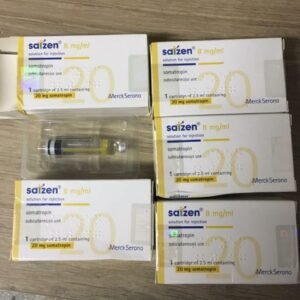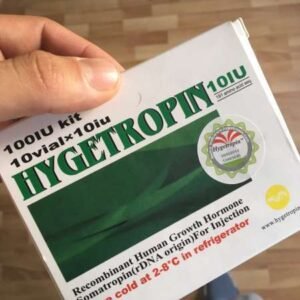Understanding Paratropin: The Multifaceted Benefits of Somatropin
What is Paratropin?
Paratropin is a synthetic form of somatropin, which is a recombinant human growth hormone (HGH) engineered to closely mimic the natural growth hormone produced by the human pituitary gland. This man-made version plays a significant role in various medical applications, particularly in treating growth disorders in children and adolescents. Its composition consists of 191 amino acids, similar to that of natural HGH, which allows paratropin to engage with growth hormone receptors effectively, promoting growth and metabolism.
The derivation of paratropin involves biotechnological methods, particularly the use of recombinant DNA technology. By inserting the gene responsible for human growth hormone into bacterial or yeast cells, scientists can produce paratropin. This method ensures that the synthetic hormone is biologically active and has the desired therapeutic effects, making it a suitable alternative for individuals who lack natural growth hormone production due to genetic disorders or other medical conditions.
One of the unique properties of paratropin is its ability to stimulate growth in a manner parallel to natural growth hormone, making it an invaluable tool in pediatric endocrinology. It is commonly prescribed for children and adolescents with growth hormone deficiencies or other related disorders. Additionally, paratropin aids in improving body composition, increasing muscle mass, and reducing adipose tissue, contributing to enhanced physical performance and overall health.
While the benefits of paratropin extend beyond mere growth enhancement, it is critical to administer this hormone under careful medical supervision. As with any synthetic hormone, there can be side effects and potential risks. Therefore, it’s essential for healthcare providers to evaluate individual patient needs and monitor their response to treatment, ensuring optimal results while minimizing adverse effects.
Mechanism of Action
Paratropin, a synthetic form of human growth hormone (HGH), exerts its multifaceted effects through complex biochemical processes that significantly influence growth and metabolism in the body. Its primary mode of action involves the stimulation of growth in target tissues, particularly bones and cartilage. Upon administration, paratropin binds to specific receptors located on cell membranes, activating pathways that lead to cell proliferation and differentiation. This process is particularly evident in bone growth, where paratropin promotes both lengthening and thickening of the bone structure, contributing to overall skeletal development.
In addition to its role in cartilage and bone growth, paratropin significantly influences protein synthesis. It enhances the translation of mRNA into proteins, which are essential for numerous bodily functions, including muscle growth and repair. This anabolic effect on muscle tissues makes paratropin valuable for individuals seeking to improve physical performance or recover from injury. Furthermore, paratropin plays a crucial role in promoting fat utilization. By stimulating lipolysis, the breakdown of stored fat into fatty acids, paratropin helps modulate body composition, leading to reduced fat mass and potentially improved metabolic health.
The relationship between paratropin and insulin response is also noteworthy. Paratropin influences the production and activity of insulin-like growth factor (IGF-1), a hormone that mediates many of the growth-promoting effects of paratropin. IGF-1 is crucial for cell growth and development and works in concert with paratropin to enhance insulin sensitivity. This interaction helps regulate blood sugar levels, improving metabolic function. Overall, the complex biochemical actions of paratropin make it a vital player in growth, metabolism, and overall health, showcasing its significance in therapeutic and performance-enhancing applications.
Benefits of Paratropin for Children and Adolescents
The administration of paratropin, a synthetic version of growth hormone somatropin, has shown remarkable potential in facilitating healthy growth and development among children and adolescents. This treatment is particularly beneficial for those diagnosed with growth hormone deficiencies, a condition that can lead to stunted growth and various metabolic issues. Regular use of paratropin has been associated with improved height velocity, enabling children to achieve their genetic growth potential.
Clinical studies have demonstrated that paratropin therapy not only enhances physical growth but also positively impacts overall health in younger populations. For instance, a comprehensive study involving children with growth hormone deficiencies revealed that those treated with paratropin experienced significant increases in both height and bone density when compared to untreated peers. These improvements are crucial, as they contribute to normal physical development and can influence psychosocial aspects such as self-esteem and peer relationships.
Additionally, It plays a vital role in supporting metabolic functions, influencing body composition by decreasing body fat and increasing lean muscle mass. This is particularly important during the adolescent growth spurt, where rapid physical changes can be challenging for many. A case from a pediatric endocrinology clinic illustrated the transformative effects of paratropin; a teenage boy with a growth hormone deficiency reported not only increased height but also improved athletic performance and stamina, enabling him to engage fully in sports activities.
Moreover, the psychological benefits associated with paratropin are noteworthy. Children receiving treatment often experience enhanced confidence and social interactions, as their physical attributes align more closely with their peers. Through the appropriate prescription and monitoring of this meds, healthcare providers can optimize growth outcomes, ensuring that children and adolescents receive the support they need to thrive.
Potential Side Effects and Considerations
Paratropin, a synthetic variant of the growth hormone somatropin, has garnered attention for its multifaceted benefits, yet it is essential to recognize the potential side effects associated with its administration. One significant consideration involves its interference with insulin action, which can lead to increased blood sugar levels. This effect may not only complicate glucose metabolism but also present challenges for individuals with pre-existing insulin sensitivity or diabetes.
Furthermore, the rise in blood sugar levels can manifest as hyperglycemia, resulting in symptoms such as increased thirst, frequent urination, and fatigue. For those with underlying metabolic conditions, these risks become more pronounced, necessitating careful monitoring and management to mitigate adverse reactions. In addition to metabolic implications, users may experience common side effects such as joint pain, swelling, and increased muscle tension—all of which should be promptly discussed with healthcare professionals.
It is crucial to approach paratropin therapy with caution, as certain contraindications may restrict its use. Individuals with a history of malignancies, severe respiratory dysfunction, or critical illnesses may face heightened risks when considering treatment. Consequently, medical supervision is paramount to ensure that the benefits of paratropin outweigh the potential side effects. Regular blood tests and assessments can offer insight into individual responses and any necessary adjustments in dosage.
In conclusion, while paratropin presents a range of advantages related to growth and recovery, a comprehensive understanding of its potential side effects and strict adherence to safety considerations cannot be overstated. Individuals embarking on paratropin treatment should engage in open discussions with healthcare providers to customize their approach, ensuring both effectiveness and safety throughout the process.
Conclusion: The Future of Paratropin Use
In conclusion, the exploration of paratropin, particularly its active ingredient somatropin, has unveiled a range of multifaceted benefits that extend far beyond its traditional applications in pediatric growth disorders. It is imperative to recognize that somatropin plays a crucial role in enhancing not only growth in children with deficiencies but also offers potential therapeutic benefits for adults facing various health challenges, such as muscle wasting and hormonal imbalances. These emerging uses underscore the significance of paratropin in modern medicine.
Current research indicates that the implications of paratropin 100iu therapy could be profound. With ongoing studies investigating its effectiveness in improving metabolic health, cognitive function, and overall quality of life for various demographic groups, there lies a promising avenue for expanded applications. The exploration of paratropin as a means to counteract the effects of aging or to support athletes in recovery presents new opportunities for clinicians to leverage this versatile treatment.
However, while these advances are encouraging, the importance of comprehensive studies cannot be overstated. Thorough research is essential to fully understand the long-term effects, appropriate dosages, and potential side effects associated with somatropin. Investigating paratropin’s role in diverse populations, including the elderly and those with chronic illnesses, is vital to ensure safe and effective usage. As the medical community continues to uncover the capabilities of paratropin 100iu, a clearer picture of its therapeutic potential will emerge, shaping the future of its application in clinical practice.




